REPORT GATUNDU CAMP KENYA- NOVEMBER 2019
SURGEONS IN ACTION IN COLLABORATION WITH
HERNIA INTERNATIONAL
INTRODUCTION
The Gatundu campaign of November 2019 was proposed by Surgeons in Action Foundation, and the same as in the rest of the campaigns it has meant a new challenge and effort during the previous months for the creation of a team of volunteers, and above all the logistic aspects as the getting of medical surgical essential for our work, as the Gatundu Hospital does not have the necessary supply. Obviously the difficulty in communication with the responsible people of the Center in order to now the number of volunteers and material resources need for the Campaign.

The economic budget was high with the expenses of the visa, flights, transport, staying and food for the team, the Surgeons in Action Foundation and a donation of the Coro Divertimento de Pamplona in collaboration with the Zuasti Club which organized a concert in order to get funds for this Campaign.
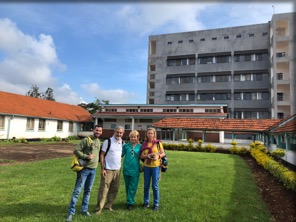
THE PLACE
Kenya, placed at the east of Africa, has a population of 51.303.010 persons. Its capital Nairobi has 3.130.000 inhabitants, and currency is the Kenyan chelin (1KES = 0’01 euros). It is a republic with many parties. The majority of its people are Christian, with 35 % Protestant and 30% Catholic, about 30% Muslim, 5% animists, with Suajili and English, apart from many tribal languages.
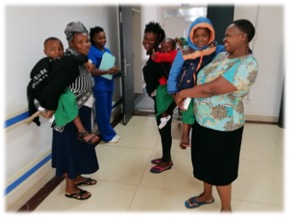
The PIB per capita of Kenya, good indicator of the life level, was 1.449 euros (Spain 28.156 dollars), and it is the 152 place in 192 countries,and the index for Human Develoment or IDH, which the United Nation elaborates to measure the progress of a country and the life level of its inhabitants, it is found in the 142 position, which indicates that its inhabitants have a very low life level. Gatundu is a small village in the Kiambu with 1.600.999 inhabitants, and it is placed at an hour by car in Nairobi. The first president o of Kenya, Jomo Kenyatta, was born here, and he has a stylish residence on top of a height over Gatundu, in contrast with the buildings in the city which are very precarious, most of the lodgings are very precarious, the majority of the lodgings and shops are at both sides of the main road; they are buildings of a single story with cheap roofs; the shops are distinguished by posters over their entrances and where they advertise their business, there are plenty of small shops of fruits and vegetables, then churches and schools of different kinds; in the side streets there are many little shops of fruits and vegetables, churches and schools of different creeds; in the side streets without asphalt the doors of the houses remain always open. People live with a dollar a day. Rice, vegetables and other products from the field are their food.
VOLUNTEERS

A team of seven volunteers of the Surgeons in Action Foundation:
2 general surgeons: Dr. Manuel Cires and Dr. José Hernandez
2 paedriatic surgeons: Dr Lola Delgado and Dr. Jesús Redondo
2 anaestetists : Dr Pilar Murga and Dr. Ana Pizarro
1 nurse: Lola García
This campaign was carried out in collaboration with the British ONG Hernia International Foundation.
We brought about 200 kg of medical-surgical material in 12 great parcels with the typical bags of rafia bought in the Chinese shops. All that was collected by the volunteers in the hospitals. The Hospital directors put at our disposal a van with a driver which took us directly from the Hotel to the Hospital, besides of the shifting to the Nairobi airport.

FOOD AND TRANSPORTATION
We were lodged at the Maxand Hotel (https://maxlandhotel.co.ke/ which is half an hour by car from Nairobi and about 20 minutes from the Gatundu hospital. It is a very safe hotel, as it is within a walled up place with entrance access controlled by safety guards. The rooms are individual with bathing room and beds with mosquito net, as also good conditions for cleanness and hygiene. It has wifi which works very well in the rooms as in the hall and dining room. Breakfast is buffet type. There is a commercial center by the side of the hotel with small shops, pizzery and a supermarket where we could buy all we needed. The price of the Hotel with breakfast and supper included is about 60 dollar a day. The pay of the Hotel can be done in dollars or with a credit card.
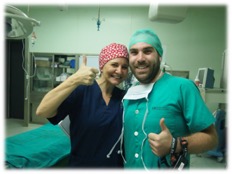
Next to the Hotel we visited a religios-focolar Center called Mariopolis Center, http://mariapolsispiero.org/mariapolis-center-wim/, which is a very quiet citadel with several buildings of friendly aspect with a friendly aspect offering the possibility of lodging at a much more reachable price about 30 dollars a day in individual lodging of 25 dollars in for sharing a room which perhaps should be valued as lodging in future campaigns in Gatundu. If more information should be needed one can contact the [email protected].
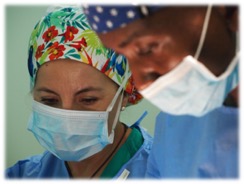
It is absolutely necessary to have local coins, the Kenyan chelin for the payment of small expenses like drinks, meals, remembrances, etc. We recommend the change to be done at the airport itself on arrival, as there are no exchange places in the Gatundu area, and they accept payment in local coins only.
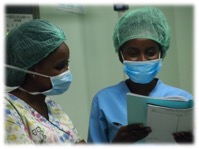
“LEVEL IV GATUNDU HOSPITAL”
It is a hospital financed and built in 2013 by China at an expense of 11 million dollars, and which was inaugurated in 2016. It is an annex to the old Gatundu Hospital made up by several one store pavilions communicated between themselves , with many green zones.
There are 5 levels; in the lower stage there are urgencies, admission and ambulatory services, two hospitalization stages, with several rooms of eight beds each where operated upon patients are lodged. An area of Gynecology and Obstetrics on the second stage, and on the third stage a surgical area which has two operation theaters called “Theaters 3 and 4” which are not sufficiently used and in which we carry out our activities.

They are wide and relatively new, although with very little material. The working of the lights is correct and steady without any need for the front lantern. They are two respirators which work well and one console of electric scalpel Valleylab in Theater 3 which works well. On Theater 4 we installed an electric scalpel which is property of our Foundation.
The REA room is very basic only. In it were monitorised patients after surgery watched upon by a lady doctor of the Hospital.
There is a room for relax for the staff which we used as an office to write down the report as also as dining room as they served there our lunch which was cooked meat, rice and vegetables, besides coffee and mineral water.

The surgical area has also a place where we placed all the material brought for the campaign; we found material from formal campaigns as mosquito nets of different sizes coming from Hernia International: sutures, dressings, general anaesthetics like Halotano, antibiotics, needles and Abocaths, needles for raquideal anaesthetics, endotraqueal tubes, larynx masks, facial masks, ventimask, vesical and nasogastric catheters, surgical and disposable dressing gowns, new pajamas, bandages, electrical stapler, skin stapler,surgical gloves, masks, antiseptics to wash hands, and other surgical instruments in good condition that allowed us to have 8 boxes and were quite usable for the Campaign. To this material has to be added the material left over at the end of the Campaign. We evaluated everything , classifying in order all the material, and we told the one responsible for the operation theater the need to make a list and inform our Foundation as perhaps we would have to take anything with us for a future campaigns.

The sterilization is carried out in autoclave the works with heat.
The operation theatre staff was directed by the chief engineer David Karuga, and we want to stress his friendliness and working power to the point of being quite necessary for our daily work. There were also Medicine students who helped us and showed much interest in knowing our work.
It is a pity we could not get the help of local surgeons, whom we did invite to take part in different surgical sessions, as the formation of personal staff is one of our first activities so that in the future perhaps our help will not be necessary. But we will also surely show our regret not to have been able to be there for the Campaign with the Director of the Centre, Dr. Gitaud, whom I finally could not meet, in spite of kept contact through electronic mail during the months previous to our coming to Kenya. It would have been much more interesting to have been able to speak of logistical questions, as the getting better patients In number as in the type of pathology, just as well as the need to have a list of the material kept in the Hospital, in order to organize future campaigns in the future. Well, it could not be, although I am not less surprised by the lack of interest and the lack of cordiality with my team.

SURGICAL ACTIVITY
Before the beginning of the Campaign a technical writing was sent telling Dr. Gitaud that the voluntaries team could carry out from 20 to 25 surgical interventions a day, giving a total number of 100-125 interventions.
Finally, during the 5 days of the Campaign 86 surgical operations took place. The patients were previously selected by local doctors, and the selection and preparation of the clinical history, was remarkable. We did not take up urgent surgical pathologies.

86 patients were operated upon, almost forty less than expected.
29 interventions on adults and 57 on children.
ADULTS:
18 Men; 11 Women
17 Inguinal hernias (Lichtenstein technique)
5 Umbilical hernias. Umbilical hernioplastia.
3 epigastrical hernias
1 Hydrocele
3 Incisional ventral hernias
General and spinal anesthetic
CHILDREN
35 MALE; 18 FEMALE
22 UMBILICAL HERNIAS – 10 INGUINAL HERNIAS – 15 CRIPTOQUIDIAL – 2 SKIN GRAFTINGS – 1 ANAL EXPLORATION – 1 URACO CYST – 1 CIRCUNSITION- 1 PENIS CURVING – 2 HIPOSPADIAS – 1 LIPOMA – HEMANGIOMA
General anaesthesia
The Campaign run from 1 to 11 November 2019.
On Friday 1 we started from Madrid and Bilbao at 6:55 h. towards Nairobi via Frankfurt with Lufthansa Airways, arriving at our destination at 21:25 hours. We went to the Maxland Hotel in Juja Citynext to G. It was a journey of more than 14 hours, which went without problems except for a difficulty during the check-in the Madrid-Barajas Airport: there was overbooking that almost left three volunteers stack, but which could be solved finally. In Kenya there was no difficulty, and the local workers were very kind.
On Saturday 2 we went to the Gatundu Hospital, where we were received by the nurse responsible for sterilization, we visited the different surgical areas and we carried out work of cleaning, orderings and classifying medico-surgical material as well as the organizing of two operation places. We could not begin on that day the surgical activities as we had planned, as we had not called any patients. From Sunday 3rd to Thursday 7 we carried out five surgery sessions between 8 and 19 hours , apart from the daily visit of patients already operated upon.
Finally, on Thursday 7th evening we started, some of us on our way to Tanzania and others to lake Naivasha where could see many hippopotamus and water birds in order to proceed in Friday 8 to the Masai Mara National Park, enjoying two rest days; we carried out a safari seeing many wild animals in their habitat, with herds of herbivorous, depredators watching and masais dressed in their traditional dresses asking for dollars for letting themselves be photographed. We went home on Sunday 10th November at 23:10 hours from the Jomo Kenyatta lntl of Nairobi, back to our places in Madrid and Bilbao at 12:35 hours of Monday 11th November. Those intense and unforgettable 11 days were thus left behind.
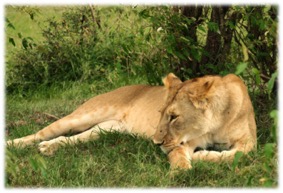
BUDGET
The cost of the medico-surgical material is not placed in this budget.
Total cost of the Campaign (visa, plane, hotel, maintenance): 7.700 euros
Cost for volunteer 1.100 euros
Signed: Dr. Manuel Cires
Gatundu Campaign responsible 2019Surgeons in Action

